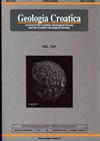暴露最古老的土壤复合体(塞尔维亚Titel黄土高原)比色指数的初步结果
IF 1.1
4区 地球科学
Q3 GEOLOGY
引用次数: 0
摘要
在本研究中,我们深入描述了都喀塔黄土古土壤序列(LPS)土壤复合体S5最低剖面的比色值。它形成于13-15年的海洋同位素阶段(MIS),代表了在伏伊伏丁那(塞尔维亚北部)Tisa河和多瑙河交汇处附近的Titel黄土高原(TLP)底部暴露的最古老的土壤复合体。将低场磁化率测量结果(χlf)与颜色特性(通过常规方法和仪器测量获得)和量化的土壤发育指数(SDI)进行比较。在这些测量中,我们发现红色指数(RI1)产生了最有用的结果,因为该指数似乎对岩性变化和土壤发育强度最敏感。还观察到χlf和a*色度之间存在高度相关性。这项研究的初步结果强调了比色法作为一种跨学科工具在评估铁磁性存在时的实用性,以及岩石磁学在多瑙河中盆地中更新世和上更新世LPS中的应用。所提出的方法可用于观察给定研究区域的气候和生态条件的演变,并用于建立欧亚LPS省各地点之间的相关性。本文章由计算机程序翻译,如有差异,请以英文原文为准。
Initial results of the colorimetric indices of the oldest exposed pedocomplex (Titel loess plateau, Serbia)
n this study we present an in-depth description of the colorimetric values for the lowest section of the Dukatar Loess Palaeosol Sequence (LPS) pedocomplex S5. Formed during the Marine Isotope Stage (MIS) 13-15, it represents the oldest pedocomplex exposed at the base of the Titel loess plateau (TLP), near the confluence of the Tisa and Danube rivers in Vojvodina (northern Serbia). The results of low-field magnetic susceptibility measurements (χlf) were compared to colour properties (obtained by conventional methods as well as instrumental measuring) and quantified Soil Development Indices (SDI). Of these measurements we found that the Redness Index (RI1) yielded the most useful results, as this index appears most sensitive to lithological changes and soil development intensity. It was also observed that a high level of correlation existed between χlf, and a* chromaticity. The initial results of this study highlight the utility of colorimetric methods as an interdisciplinary tool when evaluating the presence of ferromagnetics, and the application of rock magnetism to the Middle and Upper Pleistocene LPS of the Middle Danube Basin. The presented approach can be used to observe the evolution of climatic and ecological conditions in the given study area, and for establishing correlations between sites extending over the Eurasian LPS provinces.
求助全文
通过发布文献求助,成功后即可免费获取论文全文。
去求助
来源期刊

Geologia Croatica
GEOSCIENCES, MULTIDISCIPLINARY-
CiteScore
2.90
自引率
23.10%
发文量
35
审稿时长
>12 weeks
期刊介绍:
Geologia Croatica welcomes original scientific papers dealing with diverse aspects of geology and geological engineering, the history of the Earth, and the physical changes that the Earth has undergone or it is undergoing. The Journal covers a wide spectrum of geology disciplines (palaeontology, stratigraphy, mineralogy, sedimentology, petrology, geochemistry, structural geology, karstology, hydrogeology and engineering geology) including pedogenesis, petroleum geology and environmental geology.
Papers especially concerning the Pannonian Basin, Dinarides, the Adriatic/Mediterranean region, as well as notes and reviews interesting to a wider audience (e.g. review papers, book reviews, and notes) are welcome.
 求助内容:
求助内容: 应助结果提醒方式:
应助结果提醒方式:


